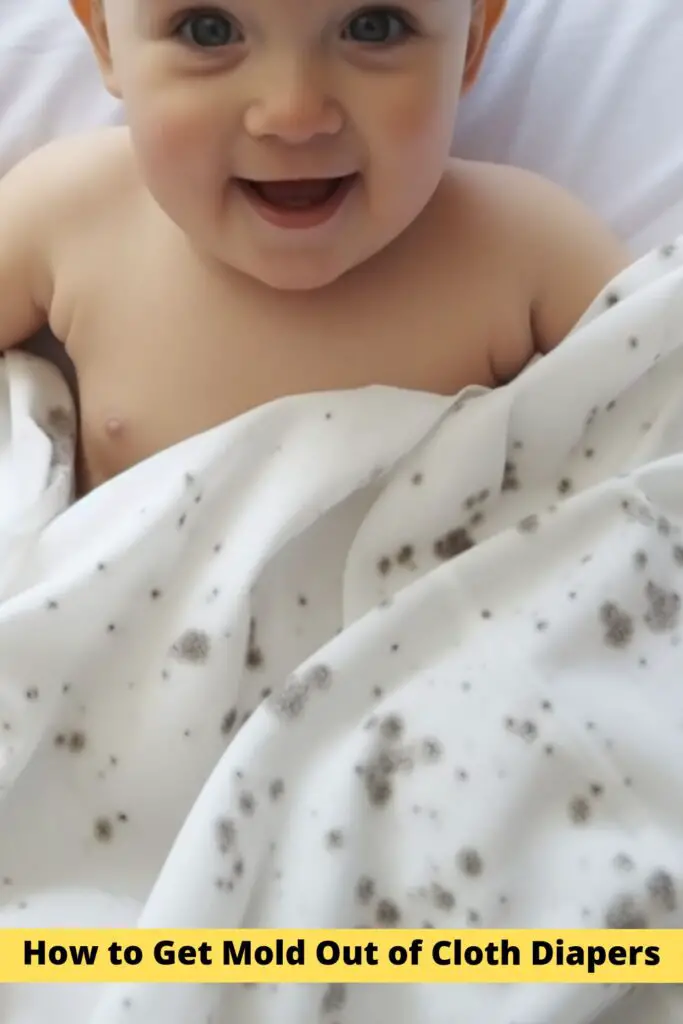Last Updated on June 5, 2025
Cloth diapers are an eco-friendly and cost-effective option for many parents. However, one common issue that arises is the presence of mold. Mold can be harmful to your baby’s sensitive skin and overall health. Furthermore, it can degrade the material of the cloth diaper, reducing its lifespan.
Therefore, knowing how to remove mold from cloth diapers effectively is crucial. This process involves identifying the presence of mold, understanding why it occurs, and learning effective and safe methods to eliminate it.
In the following content, we will delve into a comprehensive guide on how to get mold out of cloth diapers, ensuring they are safe and clean for your little one.

Easily Remove Mold from Cloth Diapers: Follow These Steps
Cloth diapers are a popular choice for many environmentally-conscious parents. However, they can sometimes harbor mold, which harms your baby’s health and the diaper’s longevity. Here is a simple guide to help you effectively remove mold from cloth diapers.
Step 1: Identify the Mold
Mold on cloth diapers usually appears as black, green, or white spots. The diapers may also have a musty smell. If you notice these signs, it’s time to start the cleaning process.
Step 2: Soak in Vinegar Solution
Vinegar is a natural mold killer. Create a solution with one part vinegar to four parts water. Soak the moldy diapers in this solution for a few hours.
Step 3: Wash with Hot Water
After soaking, wash the diapers in hot water. You can add a bit of gentle, bleach-free detergent for an extra cleaning boost.
Step 4: Dry in the Sun
Sunlight is a natural mold deterrent. After washing, hang the diapers out to dry in the sun. The UV rays will help kill any remaining mold spores.
You Might also Like These Resources!
Why Mold Grows on Cloth Diapers

Mold thrives in damp, warm environments, making cloth diapers an ideal breeding ground, especially if not cleaned and dried properly. When a wet or soiled cloth diaper is left too long before washing, or if the diaper is stored in a humid area, mold can develop.
Moreover, inadequate washing can also contribute to mold growth. If the diapers are not thoroughly cleaned, organic matter like urine and feces can remain in the fabric, providing nutrients for mold to grow. Therefore, prompt and proper cleaning prevents mold on cloth diapers.
Stop Mold on Cloth Diapers: Prevention Tips
To prevent mold growth on cloth diapers, follow these tips:
- Wash Regularly: Don’t let soiled diapers sit for too long. Try to wash them within a day of use.
- Dry Completely: Ensure that the diapers are completely dry before storing them. Consider line drying in the sun when possible.
- Store Properly: Store clean diapers in a dry, well-ventilated area. Avoid keeping them in damp rooms or sealed containers.
- Use Mild Detergent: Harsh chemicals can damage the diaper’s material, making it more susceptible to mold. Use a mild, bleach-free detergent instead.
- Check Regularly: Regularly inspect your cloth diapers for signs of mold, especially if you live in a humid climate. Early detection makes mold removal easier.
FAQs
Can Bleach Damage My Cloth Diapers?
Yes, bleach can potentially damage cloth diapers. While it’s a powerful disinfectant and can effectively kill mold, it can also weaken the fabric fibers of your cloth diapers over time, reducing their absorbency and lifespan. It’s best to use bleach sparingly and only when necessary. Mild, bleach-free detergents are generally safer for regular washing.
Can mold on cloth diapers harm my baby?
Mold can pose risks to your baby’s health. Mold can lead to skin irritation and even respiratory issues when your baby comes into contact with moldy cloth diapers. Taking prompt action is vital if you spot mold on the diapers to avoid these potential health concerns.
What are the signs of mold on cloth diapers?
Mold typically manifests as discolored spots on cloth diapers, which could be black, green, or white. These spots are often accompanied by a distinct musty odor, indicating the presence of mold growth. Being vigilant and identifying these signs can help you address the issue promptly.
Can I use vinegar to remove mold from cloth diapers?
Yes, vinegar is a natural and effective mold-fighting solution. You can use vinegar to clean moldy cloth diapers. Its acidic properties help break down and eliminate mold, restoring the diapers to a clean and safe condition for your baby’s use.
Is sunlight effective in killing mold on cloth diapers?
Sunlight is a powerful natural remedy for dealing with mold on cloth diapers. Sunlight’s ultraviolet (UV) rays have disinfecting properties that can help eliminate mold spores. Hanging moldy cloth diapers out to dry in direct sunlight is an excellent method to remove moisture and discourage mold growth, ensuring a healthier diapering experience for your baby.
Wrapping Up
Tackling mold in cloth diapers is manageable and crucial for your baby’s well-being. You can triumph over mold growth by washing with care, drying under sunlight, and maintaining a routine. Remember that consistent efforts lead to a healthier diapering experience and a happy, content baby.
Embracing these steps ensures a clean and safe environment, allowing you to cherish the joys of parenting without the worry of mold. So, take charge, follow these straightforward guidelines, and say goodbye to mold-related woes in your cloth diapering journey.
You Might Also Like These Latest Content!
